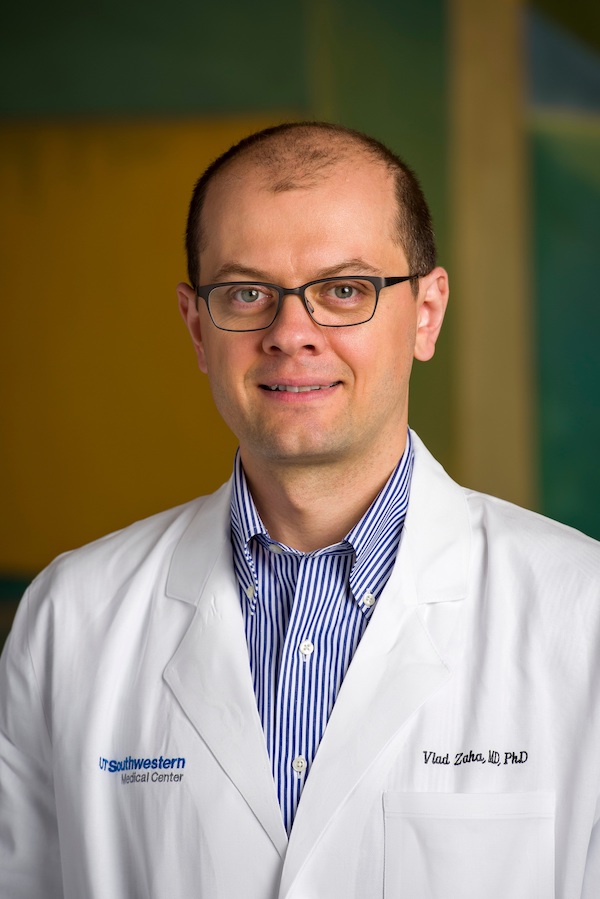Caring for your heart during cancer treatment

Amie Goins has completed eleven 5K runs this year. That’s an impressive feat for a mother working full time and raising two teenage sons – but even more so considering she was diagnosed with stage 2 breast cancer two days before Christmas last year.
She’s conquered months of treatment and difficult side effects, all while continuing to lace up. Her UT Southwestern treatment plan called for chemotherapy to shrink the tumor before surgery.
“It took me a little while to get my head around that treatment plan,” Mrs. Goins said of that conversation with Dr. Vlad Zaha, Assistant Professor of Internal Medicine. “I told him that I run about 10 miles a week, and he said, ‘You’ll be able to continue exercising. You’ll just be slower during the chemotherapy. It’ll make you tired, but exercise really does help to mitigate some of the symptoms.’”
Mrs. Goins, 46, is seeing a cardiologist because anthracyclines, a class of chemotherapy drugs used to treat breast cancer patients, can weaken the heart and lead to congestive heart failure later in some patients. Pre-emptive treatment, including exercise, can help keep the heart strong.
“I think for so many decades in medicine, the focus has just been on getting rid of the cancer,” she said. “For Dr. Zaha and all of my physicians, I know that they’re looking out for my long-term health in addition to addressing this one crisis moment with my health.”
Mrs. Goins, who started distance running a little more than a decade ago, vowed to continue exercising straight through her chemotherapy period. And she has. “I won’t say I was successful every day, but almost every day.”
Anthracyclines: A double-edged sword
Oncologists have known for more than half a century that anthracyclines, a class of drugs used to treat solid tumors, can cause damage to the heart.
Dr. Zaha, a cardiologist who specializes in heart problems caused by cancer treatment, was recently awarded a $2.3 million grant from the Cancer Prevention and Research Institute of Texas to study the metabolic changes that occur in the heart with anthracycline treatment.
The immediate goal is to identify metabolic changes that happen early on, before mechanical changes in the heart can be detected. “Currently, by the time we see signs of heart failure, damage has already been done to the heart muscle,” Dr. Zaha said.
The ultimate goal of the study is to tailor treatments to individual patients.
“Some patients might not be as sensitive and they could potentially get more treatment,” Dr. Zaha said. “And in other patients the reverse could be true. In that case, identifying the damage early on could have the potential to inform the oncologist’s treatment and lead to a decision to use alternative protocols.”
Dr. Zaha’s study will be the first large cardiology study in the nation to use a new, nonradioactive tracer-based imaging technology. The clinical diagnostic trial will enroll 100 patients over the next four years, leading to an expanded understanding of the metabolic underpinnings of anthracycline-related cardiotoxicity.
Gaining an edge with exercise
As cancer treatments improve and patients survive for longer periods of time, the need to understand long-term complications of treatment increases.

The National Cancer Institute estimates that there will be about 18 million cancer survivors in the United States by 2022. Many of those survivors will face long-term cardiovascular complications caused by chemotherapy or radiation therapy.
“The lifetime risk of heart failure increases with increasing cumulative doses of anthracyclines, but the risk is severely amplified by underlying cardiovascular risk factors in cancer survivors,” Dr. Zaha said. “Sedentary lifestyle and hypertension would be at the top of the list of traditional risk factors, and exercise helps to counterbalance both.”
Mrs. Goins, with her determination to keep running during her cancer treatment and beyond, is Dr. Zaha’s star patient. She reports the miles she’s logged each time she sees him, and once she sent him a photo of her crossing the finish line of a 5K that she won in her age category.
“It’s something where she can use exercise instead of a pill to protect her heart in the course of the treatment, and that is very inspiring,” Dr. Zaha said.
Mrs. Goins said her commitment to exercise has given her a sense of control at a time when life could easily feel like it has spun out of control. Plus, it has paid off physically. She urges anyone facing chemotherapy to do their best to remain active.
In her personal cancer journey, chemo was followed by surgery and then by radiation. “Cancer treatment does feel like a journey, and a marathon of some sort. I’m going to cross the finish line,” she said.

